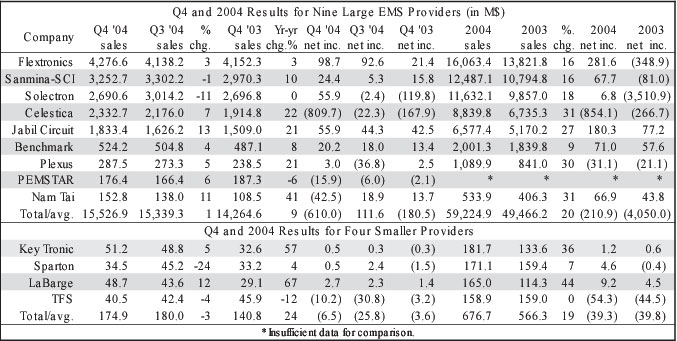

Cover Story
EMS Consolidation Grew Stronger in 2004
News
Jabil to Take Over Varian Business
EPIC Buys Operations from Two OEMs
Based on MMI’s annual tally of EMS mergers and acquisitions, more EMS operations were absorbed in 2004 than in the prior year. MMI’s annual Scorecard of M&A deals completed in 2004 shows that 16 EMS operations were acquired by or combined with EMS competitors. In 2004, the number of these EMS consolidation deals, designated “C” on the Scorecard (see p. 2-3), went up by 23% over the previous year’s adjusted total of 13.
Improving market conditions put some providers in a more acquisitive mood. With one exception, these consolidation deals were made by providers below the top tier. Growth by acquisition appeals to smaller providers who want to quickly add customers and expand geographic reach. Increasingly, sellers are motivated either to join a larger organization or exit the business.
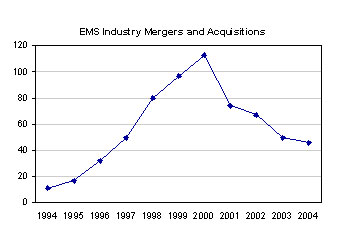
Despite the increase in EMS consolidation deals, the total number of industry transactions declined in 2004 to 46 from an adjusted sum of 50 (see chart above). That’s a decrease of 8% in the number of deals recorded by MMI. M&A levels have fallen for the four straight year since their peak in the boom year of 2000. As the years go by, it becomes increasingly unlikely that the industry will ever again see the M&A activity of the boom years. For one thing, consolidation has reduced the number of EMS providers available to make deals. In addition, OEM asset purchases have plummeted from the 2000 peak and show no signs of regaining their former prominence (see chart below).
Indeed, the falloff in OEM asset divestitures last year was most responsible for the overall decline in 2004 transactions. The scorecard lists 7 OEM asset sales concluded in 2004 compared with an updated figure of 19 such deals the year before. This 63% drop in divestitures reflects a change in the way outsourcing is conducted. EMS providers, for the most part, have lost their appetite for acquiring OEM facilities in high-cost areas. Yet OEM facilities remain largely concentrated in the high-cost regions of North America, Europe and Japan.
In the seven years that MMI has charted OEM divestitures, this is the first year that they have amounted to fewer deals than EMS acquisitions of competitors (chart below).
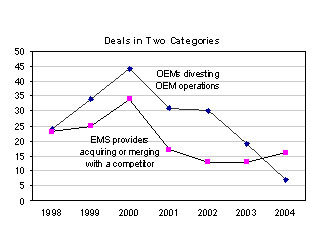
But the most common type of transaction in 2004 was what MMI calls the service or supply chain extension, labeled “S” on the Scorecard. Providers make these extension deals when they are adding horizontal capabilities beyond manufacturing in such areas as design and engineering or expanding supply chain offerings vertically in components or related areas. The 2004 Scorecard contains 20 of these service or supply chain extensions, compared with a revised total of 15 in 2003. Note that in two overlapping cases, acquisitions were classified as both OEM divestitures and service/supply chain extensions.
Flextronics alone accounted for 14 of these extension deals. The company acquired front-end capabilities including cell-phone ODM skills, software engineering in the communications space, telecom hardware design, industrial design, and multimedia expertise. On the back end, Flextronics added activities in logistics and network services. What’s more, the provider expanded its vertical offering in components with deals covering flexible circuits, lenses, scan bar sensors and cables. Flextronics was by far the most active deal maker in 2004, representing 30% of the transactions recorded on the Scorecard.
Despite consolidation and the maturing of the EMS industry, new players continue to emerge from the purchase of EMS businesses. Five such deals, marked “N” on the Scorecard, took place in 2004, versus seven the year before. These deals may occur after a parent company decides that its EMS business is no longer a core holding. Or an EMS company might divest an unwanted operation. Either way, the result is the same. New owners, typically backed by private capital, take over and turn the divested business into a new EMS company. The opportunities for making such deals, however, appear to be on the decline from a high-water mark of nine new players created in 2002.
While not as numerous as acquisitions, alliances and equity partnerships offer an alternative strategy for EMS providers seeking new capabilities or markets. Obviously, forging an alliance with a company costs far less than acquiring the company. But revenue must be split; IT must be in sync; and a provider can exert only so much control over a partner. Alliances can also come into play for the launch of a new product or platform. A technology developer will team with an EMS provider, who provides the manufacturing wherewithal. MMI recorded 12 alliances and equity partnerships for 2004, down from a revised total of 17 announced in 2003.
Editor’s note: The Scorecard of EMS industry deals completed in 2004 contains all transactions known to MMI. However, not every deal done is reported. Infrequently, an announcement is made, but does not reach MMI or comes in too late. When MMI finds past deals that were not included in Scorecard data, the data is updated to reflect those deals. As a result, the 2000 deal total was increased from 111 to 113. The 2002 total went from 64 to 67. And the 2003 figure was raised from 45 to 50.
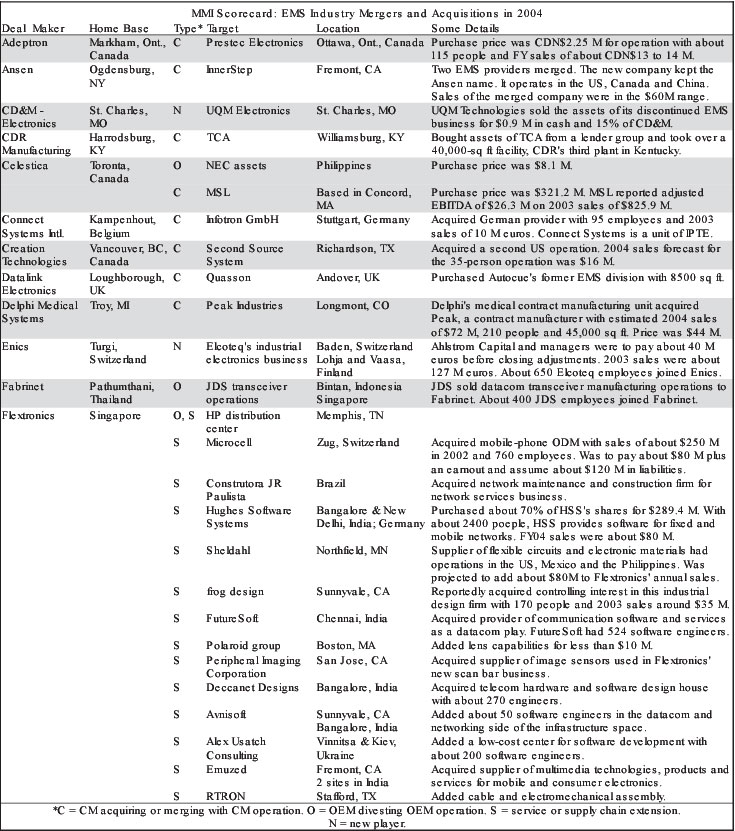
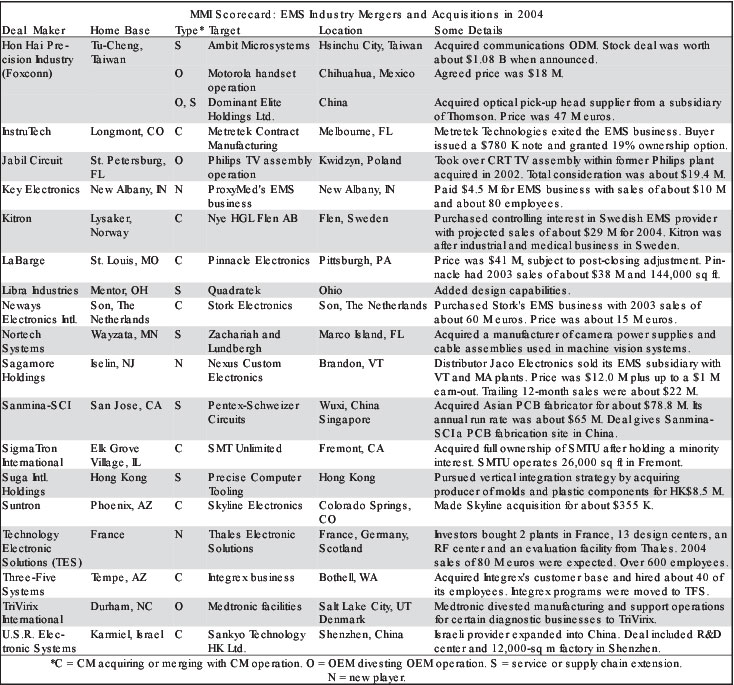
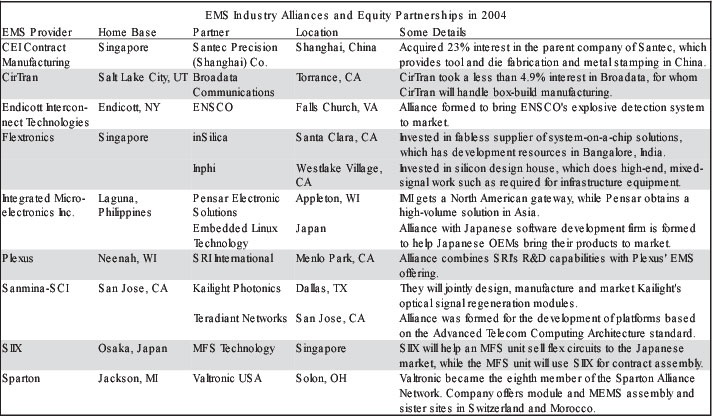
Varian (Palo Alto, CA) has entered into a definitive agreement to sell its Electronics Manufacturing business to Jabil Circuit (St. Petersburg, FL) for about $195 million in cash. The price is subject to working capital adjustments. Contingent upon customary conditions, closing is expected to occur in early March.
“The Varian business specializes in high-mix, high-complexity products in targeted industry sectors. We’ll gain know-how and additional business in the medical, instrumentation, industrial, and aerospace defense industries…,” said Timothy Main, Jabil’s president and CEO, during a conference call to discuss the deal. Reflecting Jabil’s emphasis on diversification, the deal allows the company to capitalize on high-growth markets that are in the early stages of outsourcing.
Varian Electronics Manufacturing (VEM) generated $191.5 million in sales to external customers during fiscal 2004 ended Oct. 1. Operating profit margin was 10.8%, clearly higher than Jabil’s average. In addition, VEM supplies internal customers within Varian, and fiscal 2004 sales to these customers were $18 million.
VEM operates 200,000 ft2 in Tempe, AZ; 112,000 ft2 in Poway, CA; and 37,500 ft2 in Rocklin, CA, according to the Varian website. The two smaller sites are described as leased. About 1000 employees work in this unit.
Jabil was attracted to both VEM’s customers in emerging markets and its ability to satisfy the high-complexity requirements of these markets. The deal “gives us some greater depth and some very experienced people to continue to develop business in these industry sectors,” said Main.
About 40% of VEM’s fiscal year sales came from the medical segment, and Jabil will add seven new medical customers. Aerospace represented some 15%, and Jabil will get four new customers in aerospace defense. The remaining pieces of VEM’s business are instrumentation at approximately 35% of fiscal year sales and communications at about 10%. Other new customers coming to Jabil include about seven on the industrial side.
“Today, Varian does not have a global footprint. Some of these customers are of a size and scale that they really do need to have access to a global footprint. So from a positive standpoint, this will allow those customers to deliver more volume through Varian into the Jabil footprint and gain business scale,” said Main.
But there is the potential to question Jabil’s acquisition of high-cost sites. Some might ask why Varian customers would keep manufacturing in the US if they can shift it into Jabil’s low-cost footprint. “This is not a great deal of capacity,” Main responded. “The competencies and know-how resident in the facilities are special enough and unique enough that even if some of the production moved offshore, there’s ample demand to continue to use these facilities as a window to the world, so to speak.” He thinks that over the long term Jabil will be able to continue to operate most of this capacity in place.
While Jabil already has some traction in emerging segments, “this just leapfrogs us ahead of where we think we could go just on a step-by-step basis,” said Beth Walters, VP of communications and investor relations.
Jabil reported that it is paying six to seven times EBITDA on a trailing basis. The price includes inventory worth about $35 to $40 million. Jabil stated that the transaction would be accretive to earnings during fiscal 2005.
The divestment of VEM follows Varian’s decision last year to relegate the business to non-core status. Varian defines its core business as scientific instruments and vacuum technologies.
EPIC Technologies (Rochester Hills, MI), a privately held EMS company, has acquired operations from two OEMs: Siemens Energy & Automation, or SE&A, and Philips Consumer Electronics.
SE&A (Alpharetta, GA) has sold its Electronics Manufacturing Center (EMC) business in Johnson City, TN, and South Lebanon, OH, to EPIC. The provider has also purchased a PCB assembly operation in Juarez, Mexico, from Philips Consumer Electronics. These activities will join EPIC’s existing operations in Norwalk, OH, and Juarez, Mexico. As a result of the two transactions, EPIC has established long-term relationships with Siemens and Philips, which become two of EPIC’s largest customers.
In the acquisition of the Siemens EMC business, EPIC gains a 390,000-ft2 Johnson City plant employing about 400 people and a South Lebanon operation with some 100 people. All Siemens EMC employees along with management are joining EPIC on Feb. 1, 2005. The EMC unit has supplied Siemens as well as external EMS customers.
EPIC will continue contract manufacturing at the two EMC facilities and will assume responsibility for Siemens’ current orders. The acquired operation in South Lebanon shares a 40,000-ft2 leased facility with Siemens’ Motion Control Systems activities, which are not included in the sale. Terms of the sale were not disclosed.
Both EPIC and EMC follow complementary strategies with a focus on low-to-medium volume, higher mix and complexity products in the same industry segments: medical, industrial, automotive and niche businesses. As a result of this deal, EPIC becomes a major player in the medical segment of the EMS industry. “On a combined basis, we are the third largest EMS manufacturer of medical products in the industry,” said John Sammut, president and CEO of EPIC.
EPIC also avails itself of EMC’s strength in product engineering, process development for advanced packaging, and design capabilities. EMC possesses a state-of-the-art lab for failure analysis and product validation.
The synergies don’t end there. Both parties use Siemens placement equipment and Agilent test systems. And the deal offers an opportunity to combine the purchasing power of the two parties.
Siemens had been looking for the right buyer since the company first put the EMC unit up for sale in 2002 (Aug. 2002, p. 6). At that time, Siemens decided to separate its SE&A and EMC businesses because the two businesses employed significantly different strategies. SE&A was and is an OEM organization, while EMC remains a services business.
This deal resembles the aforementioned Varian sale, which was announced a week later. In both the cases, an OEM is selling a manufacturing unit that doubles as an EMS provider. The Siemens and Varian units can be viewed as vestiges of an earlier time, when some OEMs thought it made sense to sell excess capacity rather than abandon plants to outsourcing.
The EMC unit started contract manufacturing in 1995, and by August 2002 its EMS business had grown to more than half of EMC’s total revenue. At that time, employment totaled about 830, with some 700 workers in Johnson City. Today, employment is down from those levels. Sammut reported that EMC “continues to be profitable although significantly underutilized.” Siemens purchased the Johnson City facility in 1991 from Texas Instruments and bought the South Lebanon operation in 2000 from Eaton.
EPIC focuses on lean manufacturing to achieve high throughput velocity and extreme flexibility. The company plans to apply its lean manufacturing know-how to the acquired operations.
With the Philips deal, EPIC gains its second plant in Juarez, Mexico, a 120,000-ft2 facility with 80,000 ft2 of manufacturing. The PCB assembly operation contains 7 SMT lines and 3 PTH lines. EPIC closed the deal on Dec. 31, 2004.
In July 2004, CIVC Partners (Chicago, IL), a private equity firm, teamed with management to make a significant investment in EPIC. While CIVC is the majority shareholder in EPIC, TMW Enterprises (Detroit, MI), an early-stage sponsor, remains a significant shareholder.
“The net result of these transactions allows EPIC to achieve its goal for revenue of 2005 to significantly exceed $200 million,” said Sammut. Prior to these deals, EPIC had grown by a compound annual rate of about 35% over the last five years.
In yet a third OEM sale of an internal manufacturing-cum-EMS unit, Ericsson has sold its Ericsson Anslutningssystem subsidiary (Skellefteå, Sweden) to EMS provider NOTE (Norrtälje, Sweden).
Expected to generate 2005 sales of around SEK 190 million (about $27.2 million), the acquired business carries out production development, prototype development and manufacturing of low to medium volumes for the telecom and electronics industry. The business has a number of regional customers besides Ericsson. NOTE will use the operation to step up its marketing activities in northern Sweden.
“This deal give us good coverage of product owners in the north of Sweden and is therefore an important strategic move for NOTE,” stated Erik Stenfors, NOTE’s CEO.
The Ericsson operation employed about 100 people, and they were to remain with the business, which will be renamed NOTE Skellefteå AB. Berndt Eriksson has been appointed the new managing director of the business. It was scheduled to be transferred to NOTE on January 1, 2005.
This deal also includes a long-term preferred supplier agreement with Ericsson. In addition to supplying Ericsson from the Skellefteå operation, NOTE will be providing production to Ericsson through its low-cost units and its global alliance.
NOTE expects the transaction to improve earnings per share from the second quarter of 2005. The acquired business has an operating margin of about 4%. Integration costs are estimated at SEK 2 million (about $300,000).
Enics (Turgi, Switzerland), formed last year from the sale of Elcoteq’s industrial electronics business, has announced two deals: the takeover of an OEM operation and the acquisition of another EMS company.
Under an agreement with ABB Automation Technologies in Sweden, Enics will take over PCB assembly for ABB Sweden’s power transmission protection products. As of Feb. 1, Enics will acquire an ABB manufacturing unit employing 70 people in Västerås, Sweden.
“We see solid business opportunities in the industrial electronics market in Sweden and now have an even better position to serve our customers there,” stated Reijo Itkonen, president and CEO of Enics.
Enics has also reported the acquisition of Ahltronix (Espoo, Finland), an EMS company owned by Ahlström Capital, which provided funding for the purchase of the Enics business from Elcoteq and obtained a 91% stake in Enics. The Ahltronix deal was slated to take effect on Jan. 1, 2005.
Ahltronix generates annual sales of about 35 million euros; employs some 300 people; and operates plants in Elva, Estonia, and Varkaus and Rauma, Finland. The employees and plants become part of Enics.
Started in 1979, Ahltronix has served OEMs in electrical and electronics devices, industrial automation, medical equipment and datacom.
“This move further strengthens Enics’ position as one of the largest EMS partners focused on serving industrial customers. At the same time, it supports our growth and brings highly qualified resources to us,” stated Itkonen. He reported that the customer bases of the two companies are complementary.
The two companies have worked together in the past.
With these two deals, Enics will have annual sales of about 175 million euros and an employee total of about 1200.
Hon Hai Precision Industry (Tu-Cheng, Taiwan), also known by its Foxconn trade name, has acquired AnTec Electric System Co. (Taipei, Taiwan), a manufacturer of wire harnesses, cables and electronic devices with a roster of automotive customers. What’s more, Hon Hai is reportedly involved in talks to acquire a maker of outsourced handset products through Hon Hai’s handset manufacturing unit.
In a statement to the Taiwan Stock Exchange, Hon Hai said it made the AnTec deal to acquire auto parts-related capabilities. This move follows an earlier report that Foxconn was looking to diversify into auto parts manufacturing (Dec. 2004, p. 7).
AnTec’s website lists as important customers Ford (Mazda), Nissan, Hyundai, Daewoo, GM Taiwan, VW, Honda and Sony.
Hon Hai is paying NT$370 million (about $11.7 million) for AnTec in three installments. The price is 1.29 times book value.
According to AsianProducts’ website, Antec manufactures in Taiwan (2 plants) and China (3 plants), employs 800 people, and achieved $30 million in 2003 sales.
In addition, Hon Hai is reportedly pursuing Chi Mei Communication Systems, which designs and manufacturers handset products in the outsourcing space. At least two news sources are reporting that discussions are taking place and that Foxconn International Holdings, Hon Hai’s newly listed handset unit, would be the company to make the acquisition. Chi Mei Communication Systems, whose business includes ODM work, possesses design capabilities that Hon Hai would gain if the deal is made. The targeted company is a member of Taiwan’s Chi Mei Group.
Integrated Microelectronics Inc., or IMI (Laguna, Philippines), has acquired two operations from Saturn Electronics & Engineering (Auburn Hills, MI), a privately held supplier of electronics, fuel components, solenoids and wiring. IMI has purchased the EMS and ODM assets of a Saturn unit in Tustin, CA, and high-volume SMT assembly facilities of a Saturn operation in Cebu, Philippines.
The acquisition in Tustin enhances IMI’s capabilities in product design and development, manufacturing process development, and flip chip assembly. Tustin facilities include a technology and design center, prototyping and manufacturing facilities with capabilities for flex circuit assembly of SMT and flip chips, and a program management center.
The California location also gives IMI its first North American site.
This sale will enable Saturn to focus on its core automotive and electronics businesses.
Some new programs…Plexus (Neenah, WI) has won new business from Packeteer, AMX, NMS Communications and Intermec…Among new customers added by PEMSTAR (Rochester, MN) are Cherry Corp. and Dresser Instruments. Also, PEMSTAR has completed a flight deck information panel for the Airbus A380, a new jumbo airliner….LMIC (Beltsville, MD) has entered into an agreement whereby LMIC could provide up to one million GSM cell phones for GSR Mobile (New York, NY), a prepaid cell phone provider. If all one million units are produced and sold, total revenue to LMIC is expected to be about $50.0 million….Radar Golf (Roseville, CA) has selected Integrated Microelectronics Inc. to produce a handheld golf ball finder device….Sweden-based NOTE has landed a two-year contract from Ericsson Microwave Systems AB for the manufacture of tactical radio links used in military applications.
New ODM platform…Flextronics (Singapore) and Microsoft have introduced an ODM mobile phone platform dubbed Peabody. Flextronics designed the GSM/GPRS platform based on Microsoft Windows Mobile software. Flextronics is now delivering Peabody-based devices globally. The provider also announced that it is developing a product family of devices based on next-generation Windows Mobile software for deployment on GSM/GPRS/EDGE networks.
Facility projects…Solectron (Milpitas, CA) has expanded its enclosures and sheet metal facility in Milpitas. The company said it is expecting high growth in this area, usually associated with a vertically integrated EMS offering….Celestica (Toronto, Canada) is readying two new plants, one in Romania and the other in China. The China site is in the SongShan Lake Science and Technology Park, near Dongguan City. Celestica expects to launch these plants by the beginning of Q2….Thailand-based Fabrinet has opened the first building on its new Pinehurst campus in Pathumthani, Thailand. The 115,000-ft2 building will support electronics assembly activities at the company’s Chokchai campus 7 miles away. Fabrinet has also broken ground on the new campus’s second building, scheduled for completion in December. Upon completion, Fabrinet facilities will total about 450,000 ft2 in Thailand. The Pinehurst campus, when finished, will double Fabrinet’s Thailand footprint.
